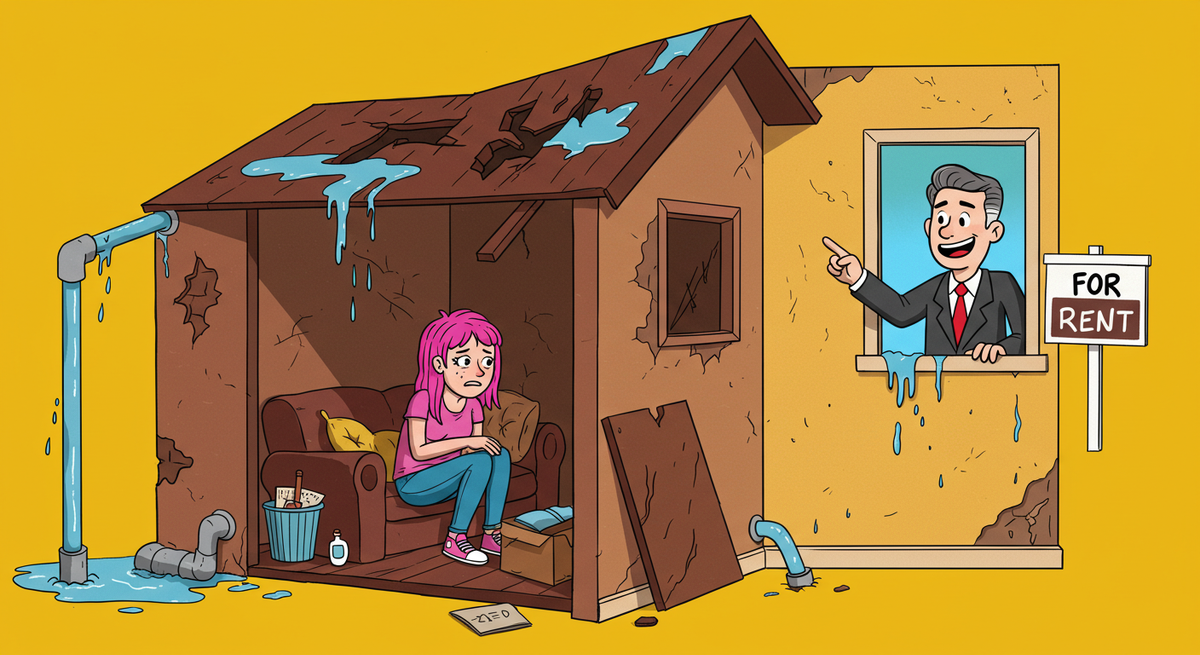Constructive Eviction in Property Management | What It Is & How It Works
Constructive eviction occurs when a landlord's actions or failures to act render a rental property uninhabitable, effectively forcing the tenant to abandon the premises without formal eviction proceedings

Property managers and landlords face numerous challenges in maintaining profitable rental operations while complying with complex tenant laws. Among the most significant legal risks is constructive eviction—a doctrine that can absolve tenants of rent obligations and expose property owners to substantial financial liability.
Constructive eviction occurs when a landlord's actions or failures to act render a rental property uninhabitable, effectively forcing the tenant to abandon the premises without formal eviction proceedings. Unlike traditional eviction processes initiated by landlords, constructive eviction represents a tenant's legal defense against rent obligations when property conditions become intolerable.
You'll learn: What constructive eviction means in legal and practical terms, how it impacts property management operations, real-world scenarios where it applies, compliance requirements across different jurisdictions, and proven strategies to prevent costly constructive eviction claims.
What Is Constructive Eviction?
Constructive eviction is a legal doctrine that occurs when a landlord breaches the implied covenant of quiet enjoyment through actions or inactions that substantially interfere with a tenant's use and beneficial enjoyment of the rental property.
This breach must be severe enough to effectively force the tenant to vacate the premises, even though no formal eviction proceedings have been initiated.
The term "constructive" in legal contexts means something is legally declared to exist even if not technically true in the traditional sense. This doctrine prevents landlords from circumventing their obligations through deliberate neglect or harassment rather than formal legal action.
Essential Elements of Constructive Eviction
Three critical elements must be present for a valid constructive eviction claim:
- Landlord's breach of duty that substantially deprives the tenant of use and enjoyment of the leased premises
- Tenant notification to the landlord with reasonable time provided for remediation
- Tenant abandonment of the rental property within a reasonable timeframe after the landlord's failure to address the issues
Variations Across Property Types
Commercial tenants and residential tenants may face different requirements under landlord tenant law:
- Commercial lease agreements typically require complete abandonment of the rented premises to claim constructive eviction
- Residential tenant protections vary by state, with some jurisdictions like California allowing rent abatement without requiring vacation of the rental unit
- Partial constructive eviction may apply when only portions of the property become uninhabitable
Why Constructive Eviction Matters in Property Management
Understanding constructive eviction is crucial for property managers because it represents both a significant financial risk and an operational challenge that can devastate rental income and property values.
Financial Impact on Property Operations
When tenants successfully prove constructive eviction, the financial consequences can be severe:
- Rent abatement from the date conditions began, potentially worth thousands in lost revenue
- Legal consequences including court costs, attorney fees, and potential punitive damages
- Liability for tenant relocation expenses and temporary housing costs
- In some jurisdictions like California, statutory penalties of $100 per day plus $2,000 one-time penalties under California law
According to legal precedents, landlords found responsible for constructive eviction may face liability dating back to when uninhabitable conditions first appeared, not just when the tenant vacated.
Operational Risks and Tenant Relations
Constructive eviction cases create operational challenges beyond immediate financial losses:
- Damage to property reputation and difficulty attracting quality tenants
- Increased scrutiny from local rent boards and housing authorities
- Potential pattern evidence in future legal proceedings against the property
- Missing this detail could cost you thousands in back rent claims and legal fees.
Real-World Applications of Constructive Eviction
Understanding how constructive eviction applies in practice helps property managers recognize and prevent potentially costly situations.
Example 1: Utility Service Interruption
- Challenge: A commercial landlord shut off electricity to force out a behind-rent tenant in a commercial lease situation
- Solution: The tenant documented the utility interruption, provided proper notice to the landlord, and vacated within two weeks
- Outcome: Court ruled in favor of the tenant, finding the landlord's action constituted constructive eviction
- Takeaway: Interrupting essential services like utilities, even for non-payment issues, can trigger constructive eviction claims under tenant law
Example 2: Unaddressed Health Hazards
- Challenge: A residential property developed severe mold issues affecting living conditions, and the landlord failed to respond to multiple tenant complaints
- Solution: The tenant provided written landlord notice, allowed 30 days for repairs per state law, then vacated when conditions worsened
- Outcome: Tenant recovered three months of rent payment plus relocation costs totaling $8,500
- Takeaway: Health and safety issues that affect habitability require immediate attention to preserve tenants quiet enjoyment rights
Example 3: Harassment and Intimidation
- Challenge: A landlord repeatedly entered a rented space without notice, changed locks, and made threats to force tenant departure
- Solution: Tenant documented all incidents, sought legal advice, and filed a constructive eviction claim after vacating
- Outcome: Court awarded damages for wrongful eviction and harassment, plus attorney fees
- Takeaway: Landlords action that violates tenant privacy and possession rights can support constructive eviction defenses
Constructive Eviction Timeline
Common scenarios showing typical progression from initial issues to legal resolution
Scenario: Utility Service Interruption
Commercial landlord shuts off electricity to force out tenant behind on rent
Scenario: Severe Health Hazards
Toxic mold discovered in residential apartment with landlord's delayed response
Scenario: Landlord Harassment Campaign
Systematic harassment including unauthorized entries and intimidation tactics
Legal and Compliance Considerations
Constructive eviction laws vary significantly across jurisdictions, making compliance a complex challenge for property managers operating in multiple markets.
Federal and State Legal Framework
While no federal statute specifically governs constructive eviction, the doctrine emerges from common law principles and state-specific real estate law:
- Implied warranty of habitability requires landlords to maintain properties in livable condition
- Covenant of quiet enjoyment prohibits landlord interference with tenant use and possession
- State statutes may define specific scenarios constituting constructive eviction
Key Legal Pitfalls to Avoid
Property managers must understand these critical compliance risks:
- Self-help eviction tactics (changing locks, removing doors, shutting off utilities) are illegal and support constructive eviction claims
- Landlords failure to address known safety hazards creates liability even without malicious intent
- Retaliatory actions against tenants who exercise tenant rights can escalate to constructive eviction scenarios
- Actual eviction proceedings don't protect landlords from constructive eviction claims for pre-existing conditions
Documentation Requirements
Courts evaluate constructive eviction claims based on evidence, making documentation crucial:
- Written tenant complaints and landlord responses with dates and details
- Photographs or inspection reports documenting property conditions
- Records of repair attempts and completion timelines
- Communication logs showing reasonable time provided for remediation
Best Practices for Preventing Constructive Eviction
Implementing systematic approaches to property maintenance and tenant relations significantly reduces constructive eviction risks.
1. Proactive Property Maintenance Programs
- What it is: Scheduled inspections and preventive maintenance before problems escalate
- Why it matters: Early intervention prevents minor issues from becoming habitability violations
- How to do it: Conduct quarterly inspections, maintain repair logs, and establish vendor relationships for emergency repairs
- Tools to use: Property management software for tracking maintenance requests and completion timelines
2. Rapid Response to Tenant Complaints
- What it is: Systematic process for addressing tenant-reported issues within legally required timeframes
- Why it matters: Swift responses demonstrate good faith compliance with lease agreement obligations
- How to do it: Acknowledge complaints within 24 hours, provide repair timelines, and follow up on completion
- Tools to use: Automated work order systems and tenant communication platforms
3. Clear Communication Protocols
- What it is: Written procedures for all landlord-tenant interactions regarding property conditions
- Why it matters: Documentation protects against misunderstandings and provides legal defense evidence
- How to do it: Use written notices for all repair communications, maintain copies, and require tenant acknowledgment
- Tools to use: Digital communication platforms with read receipts and document storage
4. Legal Compliance Monitoring
- What it is: Regular review of local tenant law changes and lease term compliance requirements
- Why it matters: Laws evolve frequently, and ignorance doesn't protect against liability
- How to do it: Subscribe to legal updates, attend property management training, and consult attorneys annually
- Tools to use: Legal compliance software and property management association resources
5. Emergency Response Procedures
- What it is: Established protocols for addressing urgent habitability issues outside normal business hours
- Why it matters: Critical problems like heating failures or water leaks can quickly escalate to constructive eviction situations
- How to do it: Maintain 24/7 emergency contractor relationships and clear escalation procedures
- Tools to use: Emergency contact systems and pre-negotiated service agreements
Related Concepts and Terminology
Understanding constructive eviction requires familiarity with interconnected legal and property management concepts.
Actual Eviction: The formal court-ordered process of removing a tenant from a rental property, contrasting with constructive eviction where tenants voluntarily leave due to uninhabitable conditions.
Implied Warranty of Habitability: The legal requirement that rental units meet minimum safety and habitability standards, forming the foundation for many constructive eviction claims when landlords fail to maintain properties.
Covenant of Quiet Enjoyment: The tenant's right to use and enjoy the leased premises without unreasonable interference from the landlord, breach of which often supports constructive eviction claims.
Partial Eviction: Occurs when a landlord's actions force a tenant to abandon only part of the rented premises, potentially reducing rent obligations proportionally rather than eliminating them entirely.
Self-Help Eviction: Illegal landlord attempts to force tenant departure through tactics like changing locks or shutting off utilities, which typically strengthen tenant defenses in constructive eviction cases.
Common Questions About Constructive Eviction
What's the difference between constructive eviction and actual eviction?
Actual eviction is a formal legal process initiated by landlords through courts to remove tenants, while constructive eviction occurs when tenants are forced to leave due to uninhabitable conditions created by the landlord. Constructive eviction serves as a tenant defense against rent payment obligations rather than a landlord remedy.
How long must tenants wait before claiming constructive eviction?
Reasonable time varies by jurisdiction and situation severity, but generally ranges from 7-30 days for critical issues like utilities or heating. California law and other state statutes may specify exact timeframes. Tenants must provide proper notice and allow landlords opportunity to remedy conditions before vacating.
Can commercial tenants claim constructive eviction without vacating?
Most jurisdictions require commercial tenants to abandon the rented space to claim constructive eviction, unlike some residential tenant protections. Commercial lease agreements typically don't provide the same habitability protections as residential properties, making complete vacation necessary for valid claims.
What constitutes proper notice for constructive eviction claims?
Proper notice must be written, clearly describe the uninhabitable conditions, specify required repairs, and provide reasonable deadlines for completion. Notice should be delivered through methods specified in the lease agreement or as required by local tenant law.
How do constructive eviction claims affect ongoing lease agreements?
Successful constructive eviction claims typically terminate the lease term and release tenants from future rent payment obligations. However, tenants may still recover previously paid rent and damages. Unsuccessful claims may leave tenants liable for breach of lease and unpaid rent.
Protecting Your Property Investment
Constructive eviction represents a serious threat to rental property profitability, but proactive management significantly reduces risks. Key takeaways for property managers include:
- Maintain properties proactively to prevent habitability issues that trigger constructive eviction claims
- Respond rapidly to tenant complaints with documented communication and reasonable repair timelines
- Understand local tenant laws and compliance requirements that vary significantly across jurisdictions
- Document all interactions to build strong defenses against potential legal challenges
Successful property management requires balancing tenant rights with operational efficiency. By implementing systematic maintenance programs, clear communication protocols, and legal compliance monitoring, property managers can protect their investments while maintaining positive tenant relationships.
Resources for Further Learning:
- National Apartment Association legal compliance guides
- Local housing authority regulations and rent board requirements
- State-specific landlord tenant law summaries and updates
- Property management software solutions for maintenance tracking
- Legal consultation services specializing in real estate law





